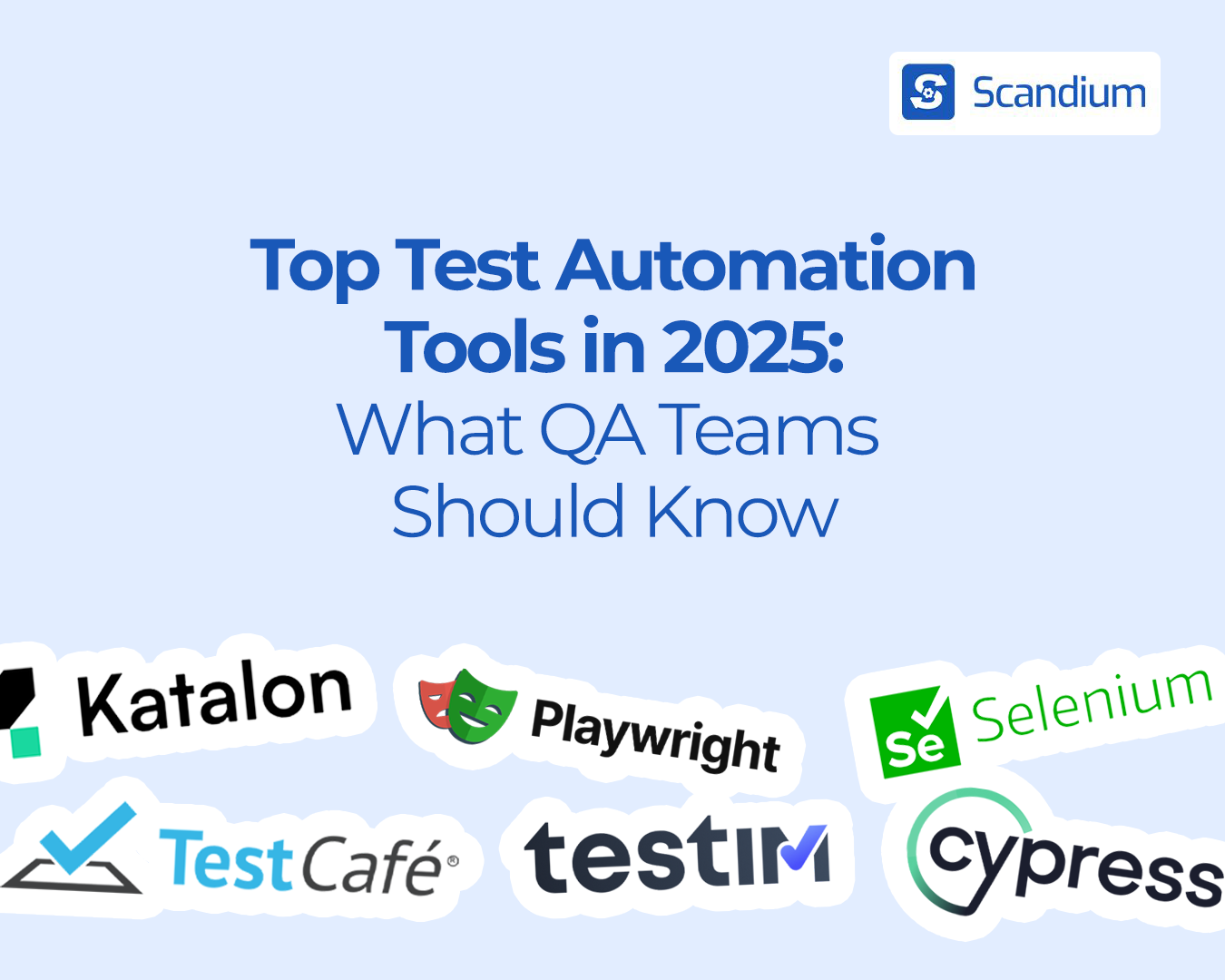
In 2025, test automation is no longer a luxury, it’s the engine of modern software delivery. As release cycles get shorter and product expectations skyrocket, QA teams around the world are turning to smarter, faster, and more scalable automation solutions.
But with so many tools available, the real question is: Which test automation tools are actually worth your time in 2025?
In this guide, we’ll walk you through the top test automation tools redefining quality assurance this year, covering everything from no-code innovation to AI-powered test execution. Whether you’re a manual tester transitioning into automation or a seasoned SDET looking for scalable solutions, this list is for you.
What Makes a Great Test Automation Tool in 2025?
Before going further, let’s clarify what QA teams value most in automation tools today:
- No-code or low-code test authoring
- AI-powered features (self-healing tests, predictive maintenance, smart reporting)
- Web, mobile, and API test coverage
- CI/CD integration and DevOps friendliness
- Collaborative interfaces for cross-functional teams
- Scalability and cloud-based execution
- Ease of onboarding for manual testers
Now let’s look at the tools that are hitting the mark.
1. Scandium – The AI-Powered No-Code Test Automation Suite

Best for: Teams looking for AI-powered, code-free test automation across Web, API, and Mobile.
What makes Scandium stand out?
Scandium is redefining how teams approach test automation. Built with manual testers, product managers, and QA engineers in mind, it allows users to create powerful test scenarios without writing a single line of code.
With Scandium, you don’t just record tests, you automate intelligently. Its AI learns from user behaviour, adapts to UI changes, and provides smart suggestions, self-healing capabilities, and insightful error diagnostics.
Key Features:
- No-code test authoring (drag, drop, and record scenarios)
- AI-powered test execution and failure diagnosis
- Full support for Web, Mobile, and API testing
- Built-in email & OTP validation testing
- CI/CD integration with Jenkins, GitLab, CircleCI & more
- Dynamic test data handling
- Team collaboration and permissions
- Detailed, AI-enhanced reporting dashboards
Why Scandium in 2025?
As no-code solutions take center stage and AI becomes more embedded in QA operations, Scandium hits the sweet spot, democratizing automation for every stakeholder in the product lifecycle.
2. Testim (by Tricentis) – AI-Powered Automation for Developers

Best for: Developers and QA engineers in Agile environments.
Testim is a popular tool among development-focused QA teams. Known for its AI-powered test creation and stabilization, it allows users to author tests via UI interaction and refine them with code where needed.
Notable Features:
- Smart locators that adjust to UI changes
- Self-healing tests
- Flexible JavaScript customization
- CI/CD support and Git integration
Testim is ideal for teams who want both visual test creation and developer-level control.
3. Playwright – The Developer’s Choice

Best for: Engineering teams that require fast, code-based browser testing.
Playwright is a free and open-source tool developed by Microsoft, supporting all modern browsers (Chromium, Firefox, WebKit). With fast execution, native mobile emulation, and excellent parallelization, it’s a favourite for tech-heavy teams.
Pros:
- Fast, reliable browser testing
- Supports multiple languages (Node.js, Python, Java, .NET)
- Headless and cross-browser by default
- CI/CD-friendly
While powerful, it has a steep learning curve, not beginner-friendly for non-technical testers.
4. TestCafe – Simplicity Meets Speed

Best for: Lightweight, script-based end-to-end testing.
TestCafe is known for its fast setup and execution, especially for testing modern web apps. It eliminates the need for WebDriver and supports parallel execution out-of-the-box.
Highlights:
- Runs on Node.js
- Easy JavaScript-based syntax
- Parallel test execution
- In-browser test debugging
If you’re looking for speed and simplicity in JavaScript-based automation, TestCafe is a solid option.
5. Selenium – The Classic That Still Delivers

Best for: Engineering teams that want maximum control and browser flexibility.
Selenium remains one of the most widely-used open-source frameworks. While not AI-powered or no-code, it offers powerful browser automation with deep customization and large community support.
Cons: High setup complexity, manual test maintenance, and lack of native reporting.
Selenium is great if your team has engineering capacity, but tools like Scandium are increasingly replacing it for teams looking to scale fast without the overhead.
6. Katalon Studio – All-in-One Platform with a Learning Curve

Best for: QA teams that need built-in tools for test creation, execution, and reporting.
Katalon offers a lot out of the box: record-and-playback, scripting, built-in CI/CD integration, and analytics. However, its interface can feel heavy, and some features are gated behind enterprise pricing.
It’s a strong contender but may not be as intuitive as Scandium for manual testers or newcomers.
7. Cypress – Fast Feedback for JavaScript-Heavy Apps

Best for: Frontend-focused testing in JavaScript-heavy environments.
Cypress runs inside the browser, making it incredibly fast for front-end testing. With automatic waiting and time-travel debugging, it provides a slick dev experience.
However, it’s limited to Chromium-based browsers and primarily suited for technical teams.
The Rise of AI in Test Automation
If one thing is clear in 2025, it’s this: AI is changing how test automation works. Tools like Scandium and Testim are leading the charge with:
- Self-healing test scripts that adapt to changes
- Predictive insights before tests fail
- Faster authoring through AI-generated steps
- Actionable reporting with suggestions, not just data
Test automation is no longer just about “testing faster”, it’s about testing smarter.
Top 10 Questions to Ask When Choosing a Test Automation Tool in 2025
Choosing the right test automation tool can feel overwhelming, especially when every platform promises speed, intelligence, and ease of use. To cut through the noise, here are 10 essential questions QA leads, developers, and product teams should ask when evaluating test automation solutions in 2025:
1. Is it truly no-code, or will I still need to write scripts?
Many tools claim to be no-code, but still require coding for anything beyond basic tests. Look for tools like Scandium that let you create complex test scenarios without a single line of code.
2. Can the tool test across Web, Mobile, and APIs in one place?
Modern QA requires multi-surface testing. Make sure your automation tool covers all environments, not just browsers.
3. How does it leverage AI in testing?
Ask whether the tool offers AI-driven features like smart locators, self-healing scripts, predictive debugging, or intelligent data generation.
4. Is it easy for manual testers to learn and use?
The best test automation tools empower non-technical users. If it requires deep coding knowledge, you may be limiting team adoption.
5. How well does it integrate with my CI/CD pipeline?
Seamless integration with Jenkins, GitHub Actions, GitLab, CircleCI, and others is a must in today’s DevOps world.
6. Does it provide real-time, actionable test reports?
You don’t just want pass/fail results, you need clear insights, error diagnostics, and suggested fixes to truly improve quality.
7. Can it scale as our testing needs grow?
Look at how well the tool supports test suites, parallel execution, and team collaboration as you grow from a few test cases to thousands.
8. Does it offer team collaboration features?
Test automation is a team sport. Look for tools with role-based access, shared test repositories, and comment/review workflows.
9. How fast can I get up and running?
Some tools take weeks to fully implement. Ask about time to first test and check if the tool offers built-in tutorials or templates.
10. What does the pricing look like for your team size and use case?
Some tools charge extra for essential features or by the number of test runs. Others (like Scandium) offer transparent pricing and startup-friendly plans.
Why Scandium is Leading the Way
In 2025, Scandium is doing more than keeping up with the curve, it’s setting the standard:
- No-code testing without sacrificing power
- AI-first design from test creation to failure detection
- Cross-platform coverage from Web to Mobile and APIs
- Ease of use that welcomes manual testers and QA engineers alike
If you’re looking to bring your QA game into the AI era without overhauling your team’s skillset, Scandium is the tool to try.
Start testing smarter at getscandium.com
Final Thoughts
Whether you’re a growing startup or an enterprise scaling agile, choosing the right test automation tool is critical in 2025. As the demands on software quality grow, your testing tools must do more than automate, they must think, adapt, and collaborate.
From AI-powered no-code solutions like Scandium to flexible scripting frameworks like Playwright and Cypress, there’s a tool for every kind of team.
But in a world moving toward speed, simplicity, and scale. Scandium is fast becoming the go-to choice for test automation that doesn’t just work, but works smart.
